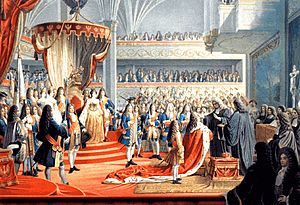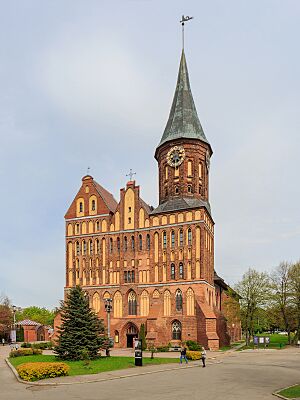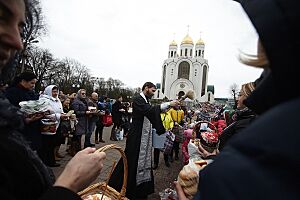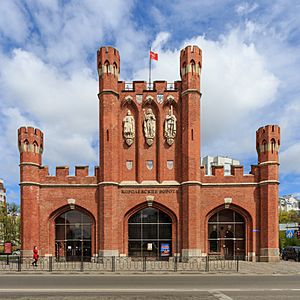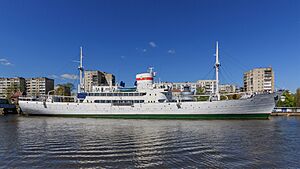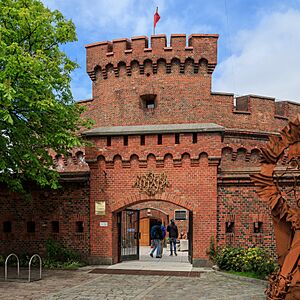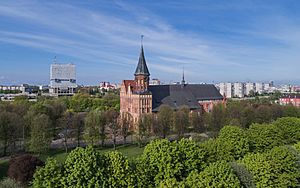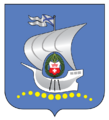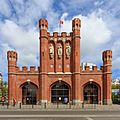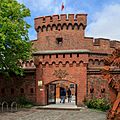Kaliningrad facts for kids
Quick facts for kids Kaliningrad (English)Калининград (Russian) |
|
|---|---|
| - City - | |
 Church of the Holy Family; Königsberg Cathedral; "Fishermen's village" in pseudo-historic style; Brandenburg Gate; King's Gate; Pregolya River |
|
|
|
|
| City Day | 4 July; observed on the first Saturday of July |
| Administrative status | |
| Country | Russia |
| Federal subject | Kaliningrad Oblast |
| Administratively subordinated to | city of oblast significance of Kaliningrad |
| Municipal status | |
| Urban okrug | Kaliningrad Urban Okrug |
| Head | Elena Ivanovna Dyatlova |
| Representative body | City Council of Deputies |
| Statistics | |
| Area | 223.03 km2 (86.11 sq mi) |
| Population (2010 Census, preliminary) |
431,402 inhabitants |
| - Rank in 2010 | 40th |
| Population (January 2018 est.) | 475,056 inhabitants |
| Density | 1,934/km2 (5,009/sq mi) |
| Time zone | USZ1 (UTC+03:00) |
| Founded | 1 September 1255 |
| Postal code(s) | 236001 - 236999 |
| Dialing code(s) | +7 4012 |
| Official website: http://www.klgd.ru | |
Kaliningrad is a major city in Russia. It was known as Königsberg until 1946. Kaliningrad is the main city and administrative center of Kaliningrad Oblast. This region is a special part of Russia, an exclave, meaning it's separated from the rest of Russia by other countries like Lithuania and Poland.
The city is located on the Pregolya River. This river flows into the Vistula Lagoon and then into the Baltic Sea. Kaliningrad is important because it's the only Russian port on the Baltic Sea that doesn't freeze in winter. In 2020, about 489,359 people lived there. It's a big city in the Northwestern Federal District of Russia, second only to Saint Petersburg. It's also one of the largest cities around the Baltic Sea.
Modern Kaliningrad was rebuilt and repopulated by Russians after 1946. The German people who lived there before were moved out. Königsberg was founded in 1255 by the Teutonic Knights. It was built on the site of an old settlement called Twangste. The city was named Königsberg to honor King Ottokar II of Bohemia. Over time, it became the capital of different states, including the Duchy of Prussia and East Prussia.
Königsberg was heavily damaged during World War II. It was bombed by the Allied powers in 1944 and captured by the Soviet Union in 1945. After the war, the Potsdam Agreement of 1945 put it under Soviet control. In 1946, it was renamed Kaliningrad. This was to honor Mikhail Kalinin, a Soviet leader. Since the dissolution of the Soviet Union in 1991, Kaliningrad has been the administrative center of Russia's westernmost region.
Kaliningrad is a big transportation hub. It has sea and river ports. It is also home to the main base of the Baltic Fleet of the Russian Navy. The city is one of Russia's largest industrial centers. It was a host city for the 2018 FIFA World Cup.
Contents
Exploring Kaliningrad's Past: A Journey Through Time
The history of Kaliningrad can be divided into four main periods. First, there was the Old Prussian settlement called Twangste before 1255. Then, it was the Polish city of Królewiec from 1454 to 1455. It was also a Polish fief (a land held under a lord) from 1456 to 1657. After that, it became the German city of Königsberg from 1657 to 1945. Finally, it became the Russian city of Kaliningrad from 1945 until today.
Ancient Roots: The Twangste Settlement

Before Königsberg, there was a fort called Twangste. This fort belonged to the Sambians, an Old Prussian tribe. The word tvinksta means "a pond made by a dam" in the Prussian language. In 1255, the Teutonic Knights conquered the Sambians. They destroyed Twangste and built a new fortress. They named it Königsberg to honor Bohemian King Ottokar II of Bohemia. Over time, the Old Prussian culture faded away. The remaining Old Prussians became part of the new population.
Königsberg: A City of Many Cultures
The city we know as Kaliningrad started as a military fortress in 1255. The Teutonic Knights built it during their Prussian Crusade against the Baltic Prussians. The new settlement was named after King Ottokar II of Bohemia. Many Germans settled there, making the city mostly German. But it also had many Polish, Lithuanian, and Latvian people.
In 1454, the city became part of Poland for a year. It was the capital of the Królewiec Voivodeship. From 1466, it was a Polish fief. This meant it was under Polish rule. When the Teutonic Order became a secular state in 1525, Königsberg became the capital of the Duchy of Prussia. It was still under Polish control. The black Prussian eagle on its flag even had a crown with the letter "S" for Polish King Sigismund I the Old.
Königsberg was a key center for Polish and Lithuanian culture. It was one of the first places to print books in Polish and Lithuanian. The University of Königsberg was the second-oldest university in the Polish–Lithuanian Commonwealth. In 1618, the Duchy of Prussia came under the control of the Electors of Brandenburg. By 1657, it was linked to Brandenburg. The city had strong ties with Poland. It also played a big role in trade between the Polish–Lithuanian Commonwealth and countries like the Netherlands and England.
From 1701, Brandenburg-Prussia became a kingdom. The whole area was called the Kingdom of Prussia. In 1734–1736, Polish King Stanisław Leszczyński stayed in the city during the War of the Polish Succession.
During the Seven Years' War, the Russian Empire took over the city from 1758 to 1762. The famous philosopher Immanuel Kant swore loyalty to Empress Elizabeth of Russia at this time.
For the next two centuries, the city grew and thrived. It was part of the Kingdom of Prussia. Then, from 1871, it was part of the German Empire. Many famous landmarks of Königsberg were built then. The city had about 370,000 people. It was a cultural and administrative center. The first civil airport in Germany opened near Königsberg in 1919.
World War II and Its Aftermath
During World War II, the city's Polish and Jewish people faced harsh treatment. They were arrested and sent to concentration camps. Many were forced to work. The city was badly damaged by British bombing in 1944. It was also heavily damaged during the Battle of Königsberg in spring 1945. The Soviet Union captured it on April 9, 1945. At the end of the war, the Potsdam Agreement of 1945 placed the city under Soviet control.
Kaliningrad: A New Era Under Soviet Rule
Old Prussians (until 1255)
![]() Teutonic Order 1255–1454
Teutonic Order 1255–1454
![]() Kingdom of Poland 1454–1455
Kingdom of Poland 1454–1455
![]() Teutonic Order 1455–1466
Teutonic Order 1455–1466
![]() Kingdom of Poland /
Kingdom of Poland / ![]() Teutonic Order (fief of Poland) 1466–1525
Teutonic Order (fief of Poland) 1466–1525
![]() Polish–Lithuanian Commonwealth /
Polish–Lithuanian Commonwealth / ![]() Duchy of Prussia (fief of Poland) 1525–1656
Duchy of Prussia (fief of Poland) 1525–1656
![]() Sweden 1656–1657
Sweden 1656–1657
![]() Duchy of Prussia 1657–1701
Duchy of Prussia 1657–1701
![]() Kingdom of Prussia 1701–1758
Kingdom of Prussia 1701–1758
![]() Russian Empire 1758–1762
Russian Empire 1758–1762
![]() Kingdom of Prussia 1762–1918
Kingdom of Prussia 1762–1918
![]() German Empire 1871–1918
German Empire 1871–1918
![]() Weimar Germany 1918–1933
Weimar Germany 1918–1933
![]() Nazi Germany 1933–1945
Nazi Germany 1933–1945
![]() Russian SFSR (as part of the Soviet Union) 1945–1991
Russian SFSR (as part of the Soviet Union) 1945–1991
![]() Russian Federation 1991–present
Russian Federation 1991–present
Under the Potsdam Agreement of August 1, 1945, Königsberg became part of the Soviet Union. This was decided while waiting for final border agreements. The city was renamed Kaliningrad in 1946. It was named after Mikhail Kalinin, a Soviet leader. Kalinin had no direct connection to the city.
The remaining German population was moved out between 1947 and 1948. The area was then settled by Soviet citizens. Most of these new residents were ethnic Russians. Some were also Ukrainians and Belarusians. The German language was replaced by Russian. By 1950, the population was about half of what it was before the war.
For many years, the city was closed to most foreigners. Only rare visits from neighboring Poland were allowed.
The old city was not rebuilt after the war. The ruins of the Königsberg Castle were torn down in the late 1960s. This happened even though architects and historians protested. The region's economy was rebuilt through fishing. Kaliningrad became a major fishing port for the USSR.
The Kaliningrad Oblast became a semi-exclave of the Russian SFSR. Some historians believe Joseph Stalin made it a separate region. This was to keep the Baltic states further from Western influence. Others think it was too important for the USSR to give to another Soviet republic. In the 1950s, Nikita Khrushchev offered the region to the Lithuanian SSR. But the Lithuanian leader refused it. This was because it would add too many ethnic Russians to Lithuania.
Kaliningrad in Modern Russia
The town of Baltiysk, near Kaliningrad, is Russia's only "ice-free" port on the Baltic Sea. This makes the region very important for the Baltic Fleet.
When the Soviet Union collapsed in 1991, Kaliningrad Oblast became an exclave of Russia. It was separated from the rest of Russia by new independent countries. This isolation grew when Poland and Lithuania joined NATO and the European Union in 2004. Now, all land travel between Kaliningrad and Russia must pass through EU and NATO countries. Special travel documents help residents move between the regions.
While some Soviet-era city names changed back, Kaliningrad kept its name. People sometimes call it König or Kyonig. There have been talks about changing the name back. But in 2022, the government said renaming the city would not be appropriate.
Some of the city's cultural heritage has been restored. The Königsberg Cathedral was rebuilt in the 1990s. This helped citizens connect with the city's German past.
Since the early 1990s, Kaliningrad Oblast has been a Free Economic Zone. In 2005, the city celebrated its 750th anniversary. Kaliningrad was one of the host cities for the 2018 FIFA World Cup.
Kaliningrad's Location and Environment
Kaliningrad is located where the Pregolya River meets the Vistula Lagoon. This lagoon is an inlet of the Baltic Sea. Ships can reach Gdańsk Bay and the Baltic Sea through the Vistula Lagoon. They also use the Strait of Baltiysk.
Before 1900, large ships couldn't reach the city's docks. They had to anchor at Pillau (now Baltiysk). Cargo was then moved to smaller boats. In 1901, a ship canal was built. This canal connected Königsberg and Pillau. It allowed larger ships to reach the city.
Kaliningrad's Climate: Seasons and Weather
Kaliningrad has a climate influenced by the ocean. Winters are cold and cloudy. Summers are mild with frequent rain and thunderstorms. Average temperatures range from about -1.5°C to +18.1°C. Rainfall varies throughout the year. The weather is generally damp, changeable, and mild. There are big temperature differences between summer and winter.
The seasons are distinct. Spring starts in March. It is cold and windy at first, then becomes warm and sunny. Summer begins in June. It is mostly warm, sometimes hot, with lots of sunshine and heavy showers. Autumn starts in September. It is warm and sunny at first, then becomes cold, damp, and foggy in November. Winter brings snow. January and February are the coldest months. Temperatures can drop to -15°C.
| Climate data for Kaliningrad (1991–2020, extremes 1848–present) | |||||||||||||
|---|---|---|---|---|---|---|---|---|---|---|---|---|---|
| Month | Jan | Feb | Mar | Apr | May | Jun | Jul | Aug | Sep | Oct | Nov | Dec | Year |
| Record high °C (°F) | 12.7 (54.9) |
16.9 (62.4) |
23.3 (73.9) |
28.5 (83.3) |
30.6 (87.1) |
34.0 (93.2) |
36.3 (97.3) |
36.5 (97.7) |
33.8 (92.8) |
26.4 (79.5) |
19.4 (66.9) |
13.3 (55.9) |
36.5 (97.7) |
| Mean daily maximum °C (°F) | 1.1 (34.0) |
2.1 (35.8) |
6.1 (43.0) |
13.1 (55.6) |
18.2 (64.8) |
21.3 (70.3) |
23.5 (74.3) |
23.3 (73.9) |
18.4 (65.1) |
12.2 (54.0) |
6.2 (43.2) |
2.6 (36.7) |
12.3 (54.1) |
| Daily mean °C (°F) | −1.2 (29.8) |
−0.6 (30.9) |
2.4 (36.3) |
7.9 (46.2) |
12.7 (54.9) |
16.1 (61.0) |
18.5 (65.3) |
18.1 (64.6) |
13.5 (56.3) |
8.4 (47.1) |
3.9 (39.0) |
0.4 (32.7) |
8.3 (46.9) |
| Mean daily minimum °C (°F) | −3.5 (25.7) |
−3.0 (26.6) |
−0.8 (30.6) |
3.4 (38.1) |
7.5 (45.5) |
11.3 (52.3) |
13.9 (57.0) |
13.3 (55.9) |
9.4 (48.9) |
5.2 (41.4) |
1.7 (35.1) |
−1.8 (28.8) |
4.7 (40.5) |
| Record low °C (°F) | −32.5 (−26.5) |
−33.3 (−27.9) |
−21.7 (−7.1) |
−5.8 (21.6) |
−3.1 (26.4) |
0.7 (33.3) |
4.5 (40.1) |
1.6 (34.9) |
−2.0 (28.4) |
−11.1 (12.0) |
−18.7 (−1.7) |
−25.6 (−14.1) |
−33.3 (−27.9) |
| Average precipitation mm (inches) | 68 (2.7) |
54 (2.1) |
49 (1.9) |
38 (1.5) |
52 (2.0) |
69 (2.7) |
91 (3.6) |
91 (3.6) |
73 (2.9) |
86 (3.4) |
76 (3.0) |
69 (2.7) |
816 (32.1) |
| Average extreme snow depth cm (inches) | 7 (2.8) |
7 (2.8) |
3 (1.2) |
0 (0) |
0 (0) |
0 (0) |
0 (0) |
0 (0) |
0 (0) |
1 (0.4) |
7 (2.8) |
13 (5.1) |
64 (25) |
| Average rainy days | 14 | 13 | 14 | 14 | 14 | 16 | 15 | 16 | 17 | 18 | 18 | 16 | 185 |
| Average snowy days | 15 | 15 | 10 | 3 | 0 | 0 | 0 | 0 | 0 | 1 | 7 | 13 | 64 |
| Average relative humidity (%) | 85 | 83 | 78 | 72 | 71 | 74 | 75 | 77 | 81 | 83 | 86 | 87 | 79 |
| Mean monthly sunshine hours | 35 | 61 | 120 | 171 | 253 | 264 | 257 | 228 | 158 | 96 | 38 | 26 | 1,707 |
| Source 1: Pogoda.ru.net | |||||||||||||
| Source 2: NOAA (sun 1961–1990) | |||||||||||||
People of Kaliningrad: Demographics and Culture
| Historical population | ||
|---|---|---|
| Year | Pop. | ±% |
| 1897 | 162,000 | — |
| 1959 | 203,570 | +25.7% |
| 1970 | 296,962 | +45.9% |
| 1979 | 354,788 | +19.5% |
| 1989 | 401,280 | +13.1% |
| 2002 | 430,003 | +7.2% |
| 2010 | 431,902 | +0.4% |
| 2021 | 490,449 | +13.6% |
| Source: Census data | ||
After World War II, the original German population left or was moved out. The Soviet Union took control of the area. By October 1945, only about 5,000 Soviet people lived there. Between 1947 and 1948, about 100,000 Germans were moved to Germany. By 1948, about 400,000 Soviet people had moved to the region.

Today, most of Kaliningrad's residents are Russians. They are descendants of those who settled there after 1945. There are also smaller groups of other Slavic people. These include Belarusians and Ukrainians. Kaliningrad also has small communities of Tatars, Germans, Armenians, Poles, and Lithuanians.
Here's a look at the ethnic groups in Kaliningrad, based on the Russian 2010 census:
| Ethnicity | total population | % of the population |
|---|---|---|
| Russians | 351,186 | 87.4% |
| Ukrainians | 16,053 | 4.0% |
| Belarusians | 15,077 | 3.7% |
| Armenians | 3,062 | 0.8% |
| Tatars | 2,075 | 0.5% |
| Lithuanians | 1,789 | 0.4% |
| Germans | 1,676 | 0.4% |
| Polish | 1,114 | 0.3% |
| Other ethnicities | 10,041 | 2.5% |
| All | 401,649 | 100.0% |
Exploring Kaliningrad's Cityscape
The old city center of Kaliningrad was heavily damaged in the war. Now, it has parks, wide streets, and a square where the old castle used to be. The Königsberg Cathedral on Kneiphof island (now "Kant island") has been restored. Immanuel Kant's grave is next to the cathedral. The House of Soviets was built where the old castle was. Many German-era buildings have been saved or rebuilt. The Königsberg Synagogue was also reconstructed. The new city center is around Victory Square. The Cathedral of Christ the Savior is on this square.
Historic Buildings and Gates
The oldest building in Kaliningrad is the Juditten Church, built before 1288. Other important buildings include the old Stock Exchange and several surviving churches. The city also has many old city gates. These include the Sackheim Gate, King's Gate, Rossgarten Gate, Attack Gate, Railway Gate, Brandenburg Gate, and Friedland Gate. The Dohna Tower, which holds the Amber Museum, and the Wrangel Tower are also reminders of the old city walls. Only the gate of the former Fort Friedrichsburg remains.
Monuments and Statues in Kaliningrad
There are many notable monuments in Kaliningrad. One is the statue of Immanuel Kant in front of the Immanuel Kant State University of Russia. This statue was made by Christian Daniel Rauch and unveiled in 1864. It was destroyed in 1945 but rebuilt in 1992.
Another important monument is the Cosmonaut monument. It honors Kaliningrad cosmonauts like Alexey Leonov and Yuri Romanenko. Other statues include those of Duke Albert, Friedrich Schiller, Mikhail Kalinin, Tsar Peter the Great, and Vladimir Vysotsky. The "Mother Russia" monument and the Monument for the 1200 Guardsmen remember the Battle of Königsberg.
Green Spaces: Parks and Ponds
Kaliningrad is known as a "green" city. It has many parks, trees, and lawns. These green spaces range from small city squares to large parks.
The Youth Recreation Park is a very popular park. It was created in the 1920s–1930s in the English style. After the war, it became popular again. It has a cafe, carting, and modern entertainment. The park is in the quiet Leningradsky area. It is connected to the Lower Pond.
The Kaliningrad Zoo opened as the Königsberg Zoo in 1896. It covers 16.5 hectares (40 acres). It has 315 species and 2,264 individual animals. The Kaliningrad Zoo is also an arboretum, which is like a botanical garden for trees.
In the city center, you'll find the Lower Pond. This is an artificial lake. It has a promenade around it, perfect for relaxation, especially in summer. North of the Lower Pond is the larger Upper Pond.
Bridges and Stadiums
Leonhard Euler's famous 1736 paper on the puzzle of the Seven Bridges of Königsberg was important for math. Only two of the bridges from his time still exist.
In 2018, the Kaliningrad Stadium was opened. It is on Oktyabrsky Island. The stadium can hold 35,000 people. It hosted games for the 2018 FIFA World Cup.
Kaliningrad's Rich Culture
Kaliningrad has a vibrant cultural scene. It offers many museums, theaters, and music events.
Museums to Explore
There are many museums in Kaliningrad, including:
- Museum of the World Ocean
- Kaliningrad Regional Museum of History and Arts
- Kaliningrad Regional Amber Museum
- Kaliningrad State Art Gallery
- Friedland Gate Museum
The Kaliningrad Regional Museum of History and Arts is the oldest museum. It was founded in 1946. It has several branches, including "Blindage" and "Fort No. 5."
In 1979, the Kaliningrad Regional Amber Museum opened. It is in the Don, a former defensive tower. It became an independent museum in 2004.
The Kaliningrad State Art Gallery opened in 1988. It is one of Russia's newest and fastest-growing museums. It holds up to 40 exhibitions each year.
The Museum of the World Ocean is unique in Russia. It has exhibitions and six museum vessels:
- Research ship-museum "Vityaz"
- Submarine B-413
- Space communication vessel "Cosmonaut Viktor Patsaev"
- Fishing boat-museum "SRT-129"
- Floating lighthouse "Irbensky"
- Icebreaker "Krassin" (moored in St. Petersburg)
The King's Gate and the preserved gate of Fort Friedrichsburg are also branches of the museum.
A museum of ancient archaeological finds is at the Friedland Gate. In 2009, the Museum of E. T. A. Hoffmann was created. Hoffman was a famous writer born in the city. In 2016, the Einstein Museum of Entertaining Sciences opened. It has interactive exhibits about science.
In 2013, about 920,000 people visited Kaliningrad's museums. This makes Kaliningrad region seventh in Russia for museum visits.
Theaters and Music Venues
Kaliningrad has several theaters:
- Kaliningrad Regional Drama Theater
- Kaliningrad Regional Musical Theater
- Kaliningrad Regional Puppet Theater
The organ hall of the Kaliningrad Regional Philharmonic is in the old Catholic Church of the Holy Family. The Königsberg Cathedral has a large concert hall with two organs. The House of Arts hosts the Variety Theater.
The city has a rich music scene. Many music festivals are held throughout the year. These include classical, jazz, and organ music festivals. The Don Cento Jazz International Jazz Festival is held in summer. The city also hosts two big rock festivals: the Night Wolves bike show and Kaliningrad In Rock. The Baltic Seasons art festival is also held every year.
In 2013, almost 345,000 people visited Kaliningrad's theaters.
Libraries for Learning
Kaliningrad has several libraries:
- Kaliningrad Regional Scientific Library
- Central City Library. A.P. Chekhov
- Kaliningrad Regional Youth Library. V. Mayakovsky
- Kaliningrad Regional Children's Library. A.P. Gaidar
- Kaliningrad Regional Specialized Library for the Blind
There are also 20 city libraries. As of 2015, over 100,000 residents regularly use the city's libraries.
Music in Kaliningrad
Modern Kaliningrad is home to the Kaliningrad Regional Philharmonic and Symphony Orchestra. It also has the Lik male chamber choir and the Garmonika Russian music ensemble. The Kaliningrad Chamber Orchestra also performs here.
Local Cuisine and Food

Kaliningrad has its own vodka, Stari Königsberg, and beer, Ostmark. Since the 1990s, many new restaurants have opened. They offer old specialties from former East Prussia, like Königsberger Klopse (meatballs in white sauce with capers). They also serve fish, salads, pizza, and sushi.
People who moved to Kaliningrad after 1945 brought their own food traditions. You can find dishes like Borscht and okroshka, common in Russia. Italian and Asian restaurants are popular. Pizza and sushi are among the most liked foods today. Fast food is also widely available. Shawarma is becoming very popular too.
Sports and Recreation in Kaliningrad
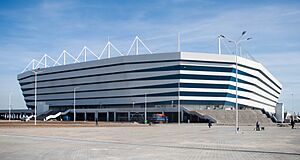
The Russian football club FC Baltika Kaliningrad is based in Kaliningrad. They play in the Russian Football National League. Their home stadium is the Kaliningrad Stadium, built for the 2018 FIFA World Cup.
From 2006 to 2013, the Dynamo-Yantar men's volleyball club played in the Russian championship. They played at the Yantarny Sports Palace, which can hold over 7,000 fans. This arena often hosted matches for the Russian men's national volleyball team.
In the past, the city had other football clubs like West and Baltika-2. There was also a rugby club called West Zvezda. In 2015, the American football team, Amber Hawks, reached the semifinals of the Polish League. In 2016, they won the silver medal in the Eastern League of American Football.
In June 2014, the Kaliningrad Regional Hockey League (KRHL) was created. This league holds the official hockey championship for the Kaliningrad region.
In 2018, Kaliningrad hosted some games of the World Cup. In April 2018, a women's volleyball team, "Lokomotiv Kaliningrad Region," was formed. In their first season (2018–2019), they finished second in the Russian Championship.
How Kaliningrad is Governed
Kaliningrad is the administrative centre of the oblast. In terms of how it's managed, it's considered a city of oblast significance. This means it has a status similar to that of a district. As a municipal division, it is known as the Kaliningrad Urban Okrug.
City Districts of Kaliningrad
As of 2014[update], the city was divided into three administrative districts:
| City district |
Russian name | Inhabitants 2010 Census |
Notes |
|---|---|---|---|
| Moskovsky | Московский | 152,165 | Named after the Russian capital, Moscow |
| Leningradsky | Ленинградский | 159,771 | Named after Leningrad, now Saint Petersburg |
| Tsentralny | Центральный | 119,966 | Means central, located northwest of the historical city center |
Two administrative districts were removed in June 2009:
| City district |
Russian name | Inhabitants 2002 Census |
Notes |
|---|---|---|---|
| Baltiysky | Балтийский | 68,664 | Named after the Baltic Sea |
| Oktyabrsky | Октябрьский | 43,252 | Named after the October Revolution |
Images for kids
See also
 In Spanish: Kaliningrado para niños
In Spanish: Kaliningrado para niños



